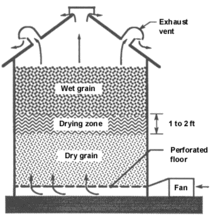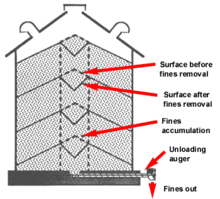If you harvest grain at high moisture content, you need to artificially dry it to 13 to 14 percent moisture for safe storage. Crop producers sometimes harvest wetter-than-usual grain to reduce harvest losses or because of wet weather.
There are two basic types of grain dryers:
-
Dryers that use no heat (natural-air dryers) or very little heat (low-temperature dryers).
-
Dryers that heat drying air to temperatures greater than 100 degrees Fahrenheit (high-temperature or high-speed dryers).
Natural-air and low-temperature drying
In natural-air and low-temperature drying, grain is slowly dried in storage over three to six weeks.
Equipment
Recommended equipment for natural-air drying includes:
-
A relatively short bin (sidewalls less than 18 feet high).
-
A fully perforated floor.
-
A drying fan that can push air up through the grain at a rate of 0.5 to 1.0 cubic feet per minute (cfm) per bushel of grain in the bin.
-
Enough vents on top to provide 1 square foot of vent area per 1,000 cfm of airflow.
Process
Figure 1 illustrates the natural-air drying process. A 1- to 2-foot thick drying zone develops near the floor and slowly moves up through the bin.
Grain below the zone comes to an approximate equilibrium with drying air, and is usually dry enough for safe storage. Grain at the top of the bin remains at its initial moisture content until the drying zone moves completely through the bin.
You need to provide enough airflow (i.e., install a large enough fan) so the top grain dries before it spoils.
Airflow
The airflow required for natural-air drying depends on the grain's initial moisture content and the weather during drying. Research and on-farm experience indicate the airflows given in Table 1 should allow drying without spoilage nearly every year.
Values in table 1 are for natural-air and low-temperature wheat and barley drying, with minimum airflow in cubic feet per minute (cfm).
Table 1: Recommended airflow
| Moisture content | Minimum airflow |
|---|---|
| 16% wet basis | 0.5 cfm per bushel |
| 17% wet basis | 0.75 cfm per bushel |
| 18% wet basis | 1.0 cfm per bushel |
How to estimate static pressure and fan power requirements
Removing fines
Fines—such as small pieces of weed seeds, soil and broken kernels—increase grain’s resistance to airflow. You need larger fans to overcome this resistance. Also, fines are more susceptible to attack by molds and insects than whole kernels.
This is why it’s better to remove fines before natural-air drying, such as by cleaning the grain or periodically withdrawing some grain during bin-filling (Figure 2).
Checking for spoilage
Positive pressure, or upward airflow, is recommended for natural-air drying. This way, the wet grain that’s vulnerable to spoilage is on top, where you can easily observe it.
Check the surface grain in natural-air drying bins several times a week for visible mold, heating or musty odors.
If you find problems, remove some grain, relevel the surface and continue drying. The chance of spoilage in the remaining grain greatly reduces because the airflow per bushel increases when some grain is removed.
Tables 2 and 3 indicate how dry wheat and barley will get in natural-air drying bins during various weather conditions. In Upper Midwest weather, continuous fan operation (24 hours per day, 7 days per week) dries either grain to 14 percent moisture or less in most years.
If you use a fan that has drying air flowing over the motor, the drying potential is actually slightly better than shown in the tables. This type of fan heats the air 2 to 4 degrees Fahrenheit, which reduces the relative humidity 3 to 10 percent. By increasing the temperature and reducing the humidity, grain dries an additional 0.75 to 1.0 percentage point.
Tables 2 and 3 show the equilibrium moisture content (in percent wet basis) for the corresponding grain exposed to air at various temperatures and humidities.
Table 2: Equilibrium moisture content for wheat
| Temperature | 20% relative humidity | 40% relative humidity | 60% relative humidity | 80% relative humidity |
|---|---|---|---|---|
| 40 F | 8.5% wet basis | 11.7% wet basis | 14.6% wet basis | 18.0% wet basis |
| 50 F | 8.2% wet basis | 11.3% wet basis | 14.2% wet basis | 17.4% wet basis |
| 60 F | 7.9% wet basis | 11.0% wet basis | 13.7% wet basis | 16.9% wet basis |
| 70 F | 7.7% wet basis | 10.7% wet basis | 13.3% wet basis | 16.5% wet basis |
| 80 F | 7.5% wet basis | 10.4% wet basis | 13.0% wet basis | 16.0% wet basis |
Table 3: Equilibrium moisture content for barley
| Temperature | 20% relative humidity | 40% relative humidity | 60% relative humidity | 80% relative humidity |
|---|---|---|---|---|
| 40 F | 6.5% wet basis | 9.4% wet basis | 12.2% wet basis | 15.6% wet basis |
| 50 F | 6.4% wet basis | 9.3% wet basis | 12.1% wet basis | 15.4% wet basis |
| 60 F | 6.3% wet basis | 9.2% wet basis | 11.9% wet basis | 15.2% wet basis |
| 70 F | 6.2% wet basis | 9.1% wet basis | 11.8% wet basis | 15.0% wet basis |
| 80 F | 6.1% wet basis | 9.0% wet basis | 11.7% wet basis | 14.9% wet basis |
Evaluating your options
Because average weather conditions are normally adequate for drying grain, it’s generally better to continuously operate fans and use air that isn’t heated (except by the fan).
If you only run the fan during warm, dry weather, grain at the bottom of the bin will be badly overdried and it’ll take more days to push the drying zone through the bin. Adding extra heat will slightly speed drying, but it’ll overdry grain at the bottom of the bin and increase drying costs. In most cases, you’d be better off installing a larger fan instead of a heater.
If you find that your grain doesn’t quite get dry enough in natural-air dryers, then adding a small amount of heat might be appropriate. Make sure the heater doesn’t increase the air temperature more than about 5 degrees Fahrenheit, or you’ll definitely have a problem with over-drying.
Advantages of natural-air drying include:
-
High-quality dried grains. Compared to grain from high-temperature dryers, grain from natural-air dryers has higher test weight and germination and is less susceptible to breakage.
-
Less labor required during harvest. However, natural-air drying requires more labor after harvest to check the drying progress.
- Ability to fill the bin as fast as you want. This is because grain is dried in storage after harvest. You don't have to stop combining to wait for the dryer to catch up, which sometimes happens with high-temperature drying.
High-temperature drying
In high-temperature drying (also called high-speed drying), large volumes of air are heated to temperatures of 100 degrees Fahrenheit or higher. Grain is dried in a few hours or a few days.
Dryer temperature
You can use high-temperature corn dryers for wheat and barley, but you might have to reduce the drying air temperature to avoid losing starch quality and germination. Adjust dryer temperature to keep kernel temperature of grain:
-
Below 140 degrees Fahrenheit for milling.
-
Below 110 degrees Fahrenheit for seed and malting barley.
Cooling
Grain needs to be cooled to outdoor temperature shortly after high-temperature drying.
You can rapidly do this using high airflow in the high-temperature dryer, but rapid cooling causes stress cracks in kernels that lead to breakage in handling. To reduce stress cracking, unload grain while it’s still hot and slowly cool it in storage (over a period of 12 to 24 hours).
With high-temperature drying, you can:
-
Harvest grain at any moisture.
-
Dry it quickly.
-
Sell it soon after harvest without moisture discounts.
-
More precisely control final moisture content compared to natural-air drying, once the dryer is properly adjusted.
Reviewed in 2021



